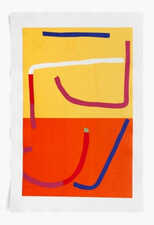Contemporary Artist's Sculptures and Prints Featured at the Clark| 11:53AM / Thursday, February 09, 2023 | |
 | | Image: Elizabeth Atterbury, Calendar 15, 2022, chine collé and embossment with hand cut copper plates on Somerset. Courtesy of the artist and Mrs., Maspeth, NY. |
WILLIAMSTOWN, Mass. — The Clark Art Institute continues its art in public spaces program in 2023 with a year-long installation presenting the work of contemporary artist Elizabeth Atterbury.
"Elizabeth Atterbury: Oracle Bones" is a free exhibition on view in the Clark Center's lower level and in the reading room of the Manton Research Center through January 21, 2024.
"Since we began our program of installing contemporary art in our public spaces in 2018, we have been able to introduce the work of many remarkable artists and present a unique platform for their creative and intriguing projects," said Olivier Meslay, Hardymon Director of the Clark. "We are delighted to continue this series in collaboration with Elizabeth Atterbury, whose extremely personal works bring the past and present into a fascinating dialogue."
According to a press release, Atterbury, who works in a variety of media, makes geometric prints using chine collé and embossment; textured monochrome reliefs in raked mortar; and wood and stone sculptures that enlarge objects of personal significance.
Throughout her practice, Atterbury considers questions of legibility and opacity, improvisation and play, and object-making and remaking as ways to think through her family histories and Chinese American heritage.
The exhibition's title, "Oracle Bones," refers to pieces of ox bone or tortoise shell that were traditionally used in late Shang Dynasty China (second millennium BCE) for pyromancy—a practice of divining supernatural instruction through the use of fire. Diviners (the oracles) would submit questions to deities by carving them onto the bone or shell using a sharp tool. Intense heat was then applied to the bone until it cracked due to thermal expansion. The diviner would then interpret the pattern of cracks to provide answers to the questions asked.
The script carved into the oracle bones represents the earliest known form of Chinese writing—a fact first recognized by Atterbury's great-great-grandfather, the scholar Wang Yirong.
During the Boxer Rebellion, Wang was charged by the fleeing emperor with the defense of Beijing. As the futility of the cause became clear, Wang and his wife ended their lives by jumping into a well, leaving their children in the care of others.
Atterbury, whose Chinese American mother died young, has made both of these fractured family narratives a focus of her work.
"Elizabeth Atterbury is an artist deeply sensitive to the ways that everyday objects and rituals connect to memory and sense of self. Her multi-site installation, in dialogue with the architecture of the Clark, is by turns playful and profoundly affecting," said Robert Wiesenberger, curator of contemporary projects.
About the Exhibition
Four sculptures installed in the Manton Reading Room are scaled up versions of objects that Atterbury said "carry a specific meaning and, in their remaking, undergo a change for me, becoming more known and more mysterious at the same time."
Two massive folding wood fans, mounted to the wall, are based on one that belonged to the artist's maternal grandmother and now hangs in Atterbury's studio.
A geometric fret ornament displayed on a second-floor window ledge in the room is known in Chinese decorative arts as a yunwen and leiwen (cloud and thunder) pattern and has come to symbolize longevity.
A stone sculpture on the floor beneath the fans is an overscaled version of a "chop," a handheld seal used in East Asia as a way of signing artworks or documents. The name on the bottom is concealed from view, as are five oracle bone fragments that Atterbury has built into the base.
Appearing on the double-height granite wall of the Clark Center's lower level is the artist's low relief sculpture "Who am I if not from you, did you seek me, did I reach back?" (2023).
Atterbury used a technique known as chine collé to make the prints on view in the Clark Center's lower level. The process uses thin pieces of paper which are run through a press on top of a thicker supporting sheet to produce a layered effect.
"Elizabeth Atterbury: Oracle Bones" is organized by the Clark Art Institute and curated by Robert Wiesenberger, curator of contemporary projects.
About the Artist
Elizabeth Atterbury is a sculptor, photographer, and printmaker who lives and works in Portland, Maine. Her work has recently appeared in the New England Triennial at deCordova Sculpture Park and Museum, Lincoln, Massachusetts; the Portland Museum of Art, Portland, Maine; and the Colby College Museum of Art, Waterville, Maine. She received her BA from Hampshire College, Amherst, Massachusetts and her MFA from the Massachusetts College of Art and Design, Boston.
Image: Elizabeth Atterbury, Calendar 15, 2022, chine collé and embossment with hand cut copper plates on Somerset. Courtesy of the artist and Mrs., Maspeth, NY.
| 
